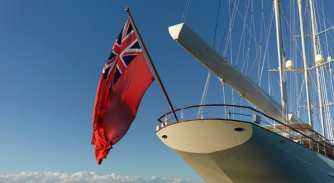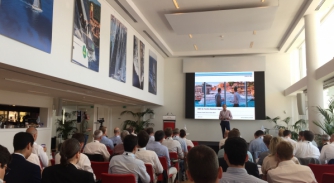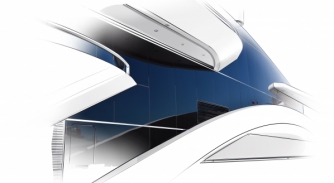A new frontier for underwater glass design
With the ever-growing trend towards underwater structural glass, Henning von der Thusen, managing director at TILSE, explains the challenges…
Over the past 30 years, TILSE has worked on more than 300 superyacht projects, most of which are custom or one-off builds. During this time, TILSE has pioneered many of the techniques that have allowed glass to become fundamental to boundary-pushing yacht design.
As part of the ISO working group dedicated to glass manufacturing and safety, TILSE has played a leading role, along with other leading glass suppliers, in the formation of safety standards that have underpinned this evolution of glass as a medium in superyacht construction.
Henning von der Thüsen, managing director at TILSE, has seen many trends come and go in the world of superyacht design – starting with the move away from framed windows towards bonded glass, and then towards ever larger windows on the superstructure. He explains that in recent years, many designers and naval architects have been looking below the waterline as a new design frontier for glass.
 Henning von der Thüsen, managing director at TILSE
Henning von der Thüsen, managing director at TILSE
TILSE has completed many below-waterline installations for some of the industry’s leading shipyards, and von der Thüsen has some fascinating insights on the technical challenges associated with safety underwater. “When you design and build a house, once completed, you can expect it to remain stable,” he says. “For a modern superyacht, this is just the start. As it sails, it constantly interacts with its environment in unexpected ways. Vessels sag and hog in complex ways. This has equally complex effects on the glass that is installed.”
This movement is often measured in millimetres, but its associated interaction with a material as brittle as glass is a vital consideration. An issue for all glass on board, this interplay is amplified by below-water installations.
“The water pressure calculations are, comparatively, relatively easy,” adds von der Thüsen. “What is significantly harder to quantify is how the subtle movement of the hull across different temperatures and conditions will affect the glass.”
The technological advancements that have made these installations possible have not been limited to the glass itself. To confidently produce these underwater installations, TILSE relies on equally advanced computer FEM (finite element method) modelling to precisely test the complex lifespan of an underwater glass installation.
FEM is a popular method for numerically solving differential equations arising in engineering and mathematical modelling. Typical problem areas of interest include the traditional fields of structural analysis, heat transfer, fluid flow, mass transport and electromagnetic potential. For TILSE, it’s the complex web of interactions between glass and the surrounding hull below the waterline.
Underwater installations are required by Flag and Class to be in a section of the vessel that can be sealed via watertight doors and is not integral to the overall buoyancy calculations of the vessel. With careful design, these somewhat unsightly watertight doors can be hidden creatively.
While this redundancy is a key safety feature, the real security for a yacht is knowing that any glass installed underwater from TILSE is of such a high safety rating that it’s actually rated higher than the surrounding steel or aluminium. The compound glass structure, which may have as many as 13 component layers, is not your typical glass window. Even if an underwater object is hit hard enough to break an outer layer, the glass will retain its structural integrity.
“There has been significant pressure from clients for more creative under- water installations,” concludes von der Thüsen. “We are working hard, along with the other members of the ISO working group, to find solutions. We are pushing the Flag states and Class societies, who are pushing back in a way that is constructive and safe, which is the most important consideration.”
NEW: Sign up for SuperyachtNewsweek!
Get the latest weekly news, in-depth reports, intelligence, and strategic insights, delivered directly from The Superyacht Group's editors and market analysts.
Stay at the forefront of the superyacht industry with SuperyachtNewsweek
Click here to become part of The Superyacht Group community, and join us in our mission to make this industry accessible to all, and prosperous for the long-term. We are offering access to the superyacht industry’s most comprehensive and longstanding archive of business-critical information, as well as a comprehensive, real-time superyacht fleet database, for just £10 per month, because we are One Industry with One Mission. Sign up here.
Related news

REG gathers for Technical Forum
Red Ensign Group brings together expertise from across its members in Southampton from 7 to 8 March 2023
Business

Lloyd’s Register’s role as a trusted Class adviser
CEO Nick Brown explains how the global company wants to work with owners and stakeholders to find safe, reliable and sustainable solutions
Technology

DNV Superyacht Seminar - Superyachts of the future
DNV is returning to the Yacht Club de Monaco, on June 28th 2022, for a discussion on the road to decarbonisation and digitalisation
Technology

TILSE YACHT GLAZING – pioneers of new trends in superyacht glass
The team at TILSE have played a key role in the new wave of glass in the design and build process
Fleet
Related news
REG gathers for Technical Forum
3 years ago
NEW: Sign up for
SuperyachtNewsweek!
Get the latest weekly news, in-depth reports, intelligence, and strategic insights, delivered directly from The Superyacht Group's editors and market analysts.
Stay at the forefront of the superyacht industry with SuperyachtNewsweek



